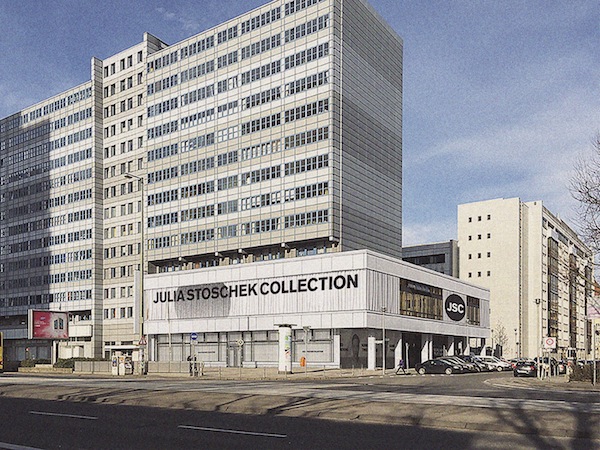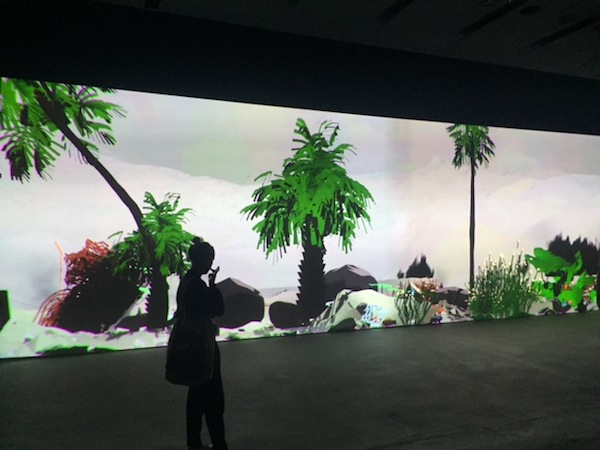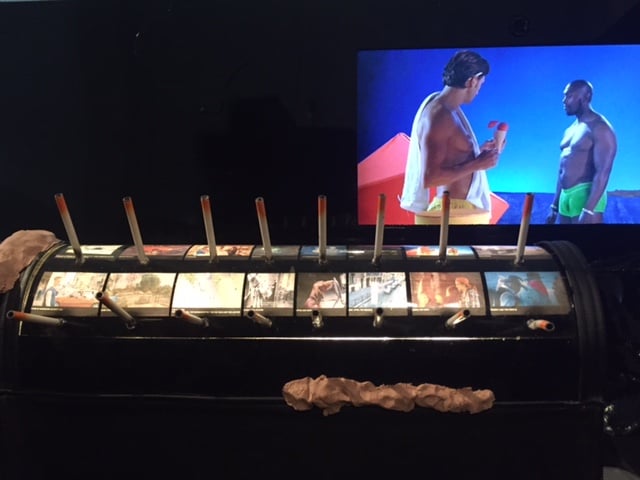Art & Exhibitions
Julia Stoschek’s Berlin Pop-Up Embraces the Ultra-Contemporary
The exhibition fits right in with the Berlin scene.

The exhibition fits right in with the Berlin scene.

Alyssa Buffenstein

Many artists and critics hesitate to use the term “post-Internet” as a serious descriptor, instead accompanying it with quotation marks and a smirk or eye roll. But with the opening of her new exhibition in a temporary space in Berlin, Düsseldorf collector Julia Stoschek embraces the post-Internet generation, the digital natives that produced the backlit banners, shining screens, and appropriative videos that open to the public on June 2.
Riffing on techno-dystopian futures, corporate identities, and, as the title, “Welt am Draht” (World on a Wire) implies, Stoschek’s selections for her Berlin satellite space explore the fine line between virtual and physical worlds, through the eyes of artists working and living with the newest technologies, dealing with themes of self-presentation, optimized imagined futures, with the help, and threat, of new media.
Of the 38 pieces on display, 11 are dated 2016, and ten from 2015. With such a focus on the ultra-contemporary, the oldest works—Hito Steyerl’s Lovely Andrea and Cao Fei’s RMB City (both from 2007)—felt already aged, not quite “post” internet, but instead precursors to artists like Ed Atkins. (Stoschek owns Us Dead Talk Love, (2012) the artist’s first two-channel, HD video featuring the CGI characters that are today his signature.) Fei’s Second Life world fails to capture the viewer’s attention in the way it might have at her recent MoMA PS1 solo show; neither is the Steyerl one of the artist’s most captivating, despite the poignant personal story it traces.

Ian Cheng, Emissary Forks at Perfection (2015). Photo courtesy of the author.
With so many different shapes and sizes of screens, all accompanied by sounds equally as shiny (and only some with headphones), the viewer is more than occasionally pulled in different directions. Jon Rafman’s Betamale Trilogy (2015) is essentially a glass cabin set up in the midst of Helen Martin’s room installation, Orchids, or a Hemispherical Bottom (2013). Both blast narrative and music at the viewer, and, like keeping multiple browser tabs open at once, the viewer naturally flips back and forth between experiencing the two.
The most exciting moving images, like the Rafman series, aren’t viewed in the museum-standard projector-and-wall setup. Wu Tsang’s A Day in the Life of Bliss (2014), a two-channel video, appears as four-channels thanks to mirrors across from each projection. Inside the installation, viewers can sink into beanbags and watch performer boychild play a fictional pop-star named Blis, dancing around an empty apartment in a future surveillance state. Britta Thie’s sound installation Translantics OST (2016) invites viewers to listen to an iPod loaded with tracks by the likes of Dan Bodan and Max McFerren while sitting on a low rocking chair.
But trumping the many opportunities for immersion and interactivity is Neïl Baloufa’s Jaguacuzzi (2015), a sculptural cubicle containing a sort of jukebox for movies, affixed with fake cigarettes. A screen prompts participants to lick a finger and touch it to the cigarette, after which their movie of choice will play.

Neïl Beloufa, Jaguacuzzi (detail) (2015). Photo by the author.
The building, a former Czech Cultural Center on Leipziger Straße allows some works—like the large, sloping, concrete room where Ian Cheng’s massive generative evolution simulation Emissary Forks at Perfection (2015), also viewable from windows through a niche of what appears to be a former control room where the Steyerl is shown—to truly shine.
Hannah Black’s digital video Bodybuilding (2015) is installed in its own room, complete with fluorescent lighting, exercise balls, and a gym bench, creating a realistic feeling of sitting in an actual weight room. The presentation is occasionally cramped, the fault of the original architecture; and some works, like Josh Klein’s 3D-printed, Stella Artois-filled Designer’s Head in Tim Coppens (TIM) (2013), feel hidden in corners.
The décor, luxurious white ruffles of curtains covering the windows, feels far from makeshift, but the re-purposing of space is typical of Berlin, and gives it the city’s signature feeling. (During preview, fresh paint fumes and the smell of newly laid wall-to-wall carpeting filled the crowded rooms).

Hannah Black, Bodybuilding (2015). Photo courtesy of the author.
Even this time last year, word on the street was that Berlin’s abundance of artists was threatened by the city’s lack of collectors, and at the press conference, Stoschek noted that the artists here are part of the city’s draw. Private collections in Berlin like the Sammlung Boros or Sammlung Hoffmann are modern, but largely still tied to old media—especially since neither seem to be expanding.
Stoschek’s arrival marks what many have been waiting for—a collector unafraid of contemporary, digital practices, who shuns the physicality of painting and sculpture. Indeed, the artist list has much in common with that of the 9th Berlin Biennale, which opens to the public one day later.
At risk of offending those who have already declared the phrase dead, one might even venture to call Stoschek, whose official focus is “time-based media art”, Germany’s foremost post-Internet collector.